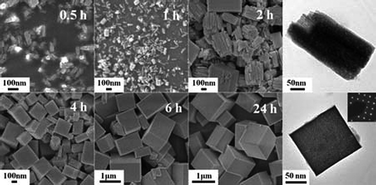Growth mechanism and cathodoluminescence properties of indium hydroxide nanocubes synthesized from a simple aqueous solution
Abstract
Single-crystalline In(OH)3 nanocubes were synthesized in a simple aqueous solution, without using a

* Corresponding authors
a
Department of Materials Science and Engineering, National Chung Hsing University, Taichung, Taiwan 40254, Republic of China
E-mail:
ycho@dragon.nchu.edu.tw
Fax: (+886)-4-22857017
Tel: (+886)-4-22859112 Ext. 506
Single-crystalline In(OH)3 nanocubes were synthesized in a simple aqueous solution, without using a

 Please wait while we load your content...
Something went wrong. Try again?
Please wait while we load your content...
Something went wrong. Try again?
S. Jean and Y. Her, CrystEngComm, 2011, 13, 2324 DOI: 10.1039/C0CE00480D
To request permission to reproduce material from this article, please go to the Copyright Clearance Center request page.
If you are an author contributing to an RSC publication, you do not need to request permission provided correct acknowledgement is given.
If you are the author of this article, you do not need to request permission to reproduce figures and diagrams provided correct acknowledgement is given. If you want to reproduce the whole article in a third-party publication (excluding your thesis/dissertation for which permission is not required) please go to the Copyright Clearance Center request page.
Read more about how to correctly acknowledge RSC content.
 Fetching data from CrossRef.
Fetching data from CrossRef.
This may take some time to load.
Loading related content
